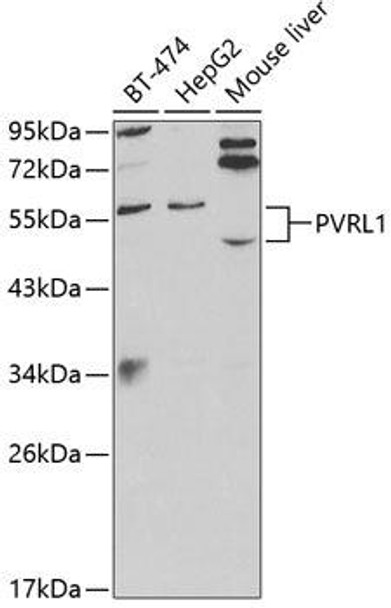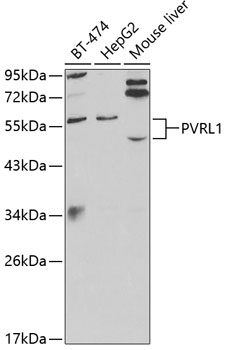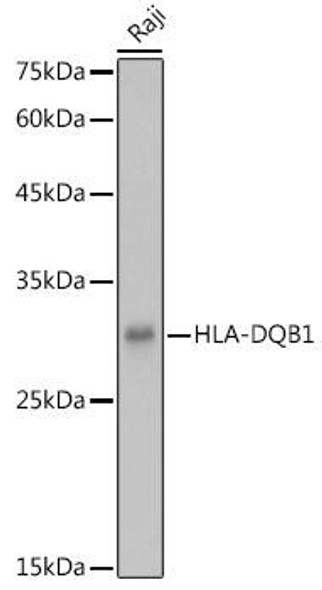Anti-PVRL1 Antibody (CAB2037)
- SKU:
- CAB2037
- Product type:
- Antibody
- Reactivity:
- Human
- Mouse
- Rat
- Host Species:
- Rabbit
- Isotype:
- IgG
- Research Area:
- Cell Biology
Description
| Antibody Name: | Anti-PVRL1 Antibody |
| Antibody SKU: | CAB2037 |
| Antibody Size: | 20uL, 50uL, 100uL |
| Application: | WB |
| Reactivity: | Human, Mouse, Rat |
| Host Species: | Rabbit |
| Immunogen: | Recombinant fusion protein containing a sequence corresponding to amino acids 70-350 of human PVRL1 (NP_002846.3). |
| Application: | WB |
| Recommended Dilution: | WB 1:500 - 1:2000 |
| Reactivity: | Human, Mouse, Rat |
| Positive Samples: | BT-474, HepG2, Mouse liver |
| Immunogen: | Recombinant fusion protein containing a sequence corresponding to amino acids 70-350 of human PVRL1 (NP_002846.3). |
| Purification Method: | Affinity purification |
| Storage Buffer: | Store at -20°C. Avoid freeze / thaw cycles. Buffer: PBS with 0.02% sodium azide, 50% glycerol, pH7.3. |
| Isotype: | IgG |
| Sequence: | STNG SKQN VAIY NPSM GVSV LAPY RERV EFLR PSFT DGTI RLSR LELE DEGV YICE FATF PTGN RESQ LNLT VMAK PTNW IEGT QAVL RAKK GQDD KVLV ATCT SANG KPPS VVSW ETRL KGEA EYQE IRNP NGTV TVIS RYRL VPSR EAHQ QSLA CIVN YHMD RFKE SLTL NVQY EPEV TIEG FDGN WYLQ RMDV KLTC KADA NPPA TEYH WTTL NGSL PKGV EAQN RTLF FKGP INYS LAGT YICE ATNP IGTR SGQV EVNI TEFP YTPS PPEH GRRA G |
| Gene ID: | 5818 |
| Uniprot: | Q15223 |
| Cellular Location: | Cell junction, Cell membrane, Secreted, Single-pass type I membrane protein, presynaptic cell membrane, synapse |
| Calculated MW: | 39kDa/50kDa/57kDa |
| Observed MW: | 55kDa |
| Synonyms: | NECTIN1, CD111, CLPED1, ED4, HIgR, HV1S, HVEC, OFC7, PRR, PRR1, PVRL1, PVRR, PVRR1, SK-12, nectin-1 |
| Background: | This gene encodes an adhesion protein that plays a role in the organization of adherens junctions and tight junctions in epithelial and endothelial cells. The protein is a calcium(2+)-independent cell-cell adhesion molecule that belongs to the immunoglobulin superfamily and has 3 extracellular immunoglobulin-like loops, a single transmembrane domain (in some isoforms), and a cytoplasmic region. This protein acts as a receptor for glycoprotein D (gD) of herpes simplex viruses 1 and 2 (HSV-1, HSV-2), and pseudorabies virus (PRV) and mediates viral entry into epithelial and neuronal cells. Mutations in this gene cause cleft lip and palate/ectodermal dysplasia 1 syndrome (CLPED1) as well as non-syndromic cleft lip with or without cleft palate (CL/P). Alternative splicing results in multiple transcript variants encoding proteins with distinct C-termini. |
| UniProt Protein Function: | nectin 1: Promotes cell-cell contacts by forming homophilic or heterophilic trans-dimers. Heterophilic interactions have been detected between PVRL1/nectin-1 and PVRL3/nectin-3 and between PVRL1/nectin-1 and PVRL4/nectin-4. Defects in PVRL1 are the cause of ectodermal dysplasia Margarita Island type (EDMI); also known as Zlotogora-Ogur syndrome, cleft lip/palate-ectodermal dysplasia syndrome (CLPED1) or ectodermal dysplasia 4. Ectodermal dysplasia defines a heterogeneous group of disorders due to abnormal development of two or more ectodermal structures. EDMI is an autosomal recessive syndrome characterized by the association of cleft lip/palate, ectodermal dysplasia (sparse short and dry scalp hair, sparse eyebrows and eyelashes), and partial syndactyly of the fingers and/or toes. Two thirds of the patients do not manifest oral cleft but present with abnormal teeth and nails. Defects in PVRL1 are the cause of non-syndromic orofacial cleft type 7 (OFC7). Non-syndromic orofacial cleft is a common birth defect consisting of cleft lips with or without cleft palate. Cleft lips are associated with cleft palate in two- third of cases. A cleft lip can occur on one or both sides and range in severity from a simple notch in the upper lip to a complete opening in the lip extending into the floor of the nostril and involving the upper gum. Belongs to the nectin family. 3 isoforms of the human protein are produced by alternative splicing. |
| UniProt Protein Details: | Protein type:Membrane protein, integral; Cell adhesion Chromosomal Location of Human Ortholog: 11q23.3 Cellular Component: presynaptic membrane; cell-cell adherens junction; adherens junction; intracellular membrane-bound organelle; membrane; axon; extracellular region; plasma membrane; integral to membrane; catenin complex Molecular Function:viral receptor activity; protein binding; protein homodimerization activity; protein heterodimerization activity; virion binding; coreceptor activity; cell adhesion molecule binding; carbohydrate binding Biological Process: intercellular junction assembly and maintenance; axon guidance; entry of virus into host cell; signal transduction; iron ion transport; heterophilic cell adhesion; cell-cell adhesion; regulation of synaptogenesis; retina development in camera-type eye; immune response; lens morphogenesis in camera-type eye; homophilic cell adhesion; cell adhesion Disease: Cleft Lip/palate-ectodermal Dysplasia Syndrome |
| NCBI Summary: | This gene encodes an adhesion protein that plays a role in the organization of adherens junctions and tight junctions in epithelial and endothelial cells. The protein is a calcium(2+)-independent cell-cell adhesion molecule that belongs to the immunoglobulin superfamily and has 3 extracellular immunoglobulin-like loops, a single transmembrane domain (in some isoforms), and a cytoplasmic region. This protein acts as a receptor for glycoprotein D (gD) of herpes simplex viruses 1 and 2 (HSV-1, HSV-2), and pseudorabies virus (PRV) and mediates viral entry into epithelial and neuronal cells. Mutations in this gene cause cleft lip and palate/ectodermal dysplasia 1 syndrome (CLPED1) as well as non-syndromic cleft lip with or without cleft palate (CL/P). Alternative splicing results in multiple transcript variants encoding proteins with distinct C-termini. [provided by RefSeq, Oct 2009] |
| UniProt Code: | Q15223 |
| NCBI GenInfo Identifier: | 18202503 |
| NCBI Gene ID: | 5818 |
| NCBI Accession: | Q15223.3 |
| UniProt Secondary Accession: | Q15223,O75465, Q2M3D3, Q9HBE6, Q9HBW2, |
| UniProt Related Accession: | Q15223 |
| Molecular Weight: | 517 |
| NCBI Full Name: | Nectin-1 |
| NCBI Synonym Full Names: | poliovirus receptor-related 1 (herpesvirus entry mediator C) |
| NCBI Official Symbol: | PVRL1 |
| NCBI Official Synonym Symbols: | ED4; PRR; HIgR; HV1S; HVEC; OFC7; PRR1; PVRR; CD111; PVRR1; SK-12; CLPED1; nectin-1 |
| NCBI Protein Information: | nectin-1; nectin 1; poliovirus receptor-like 1; herpesvirus Ig-like receptor; herpes virus entry mediator C; poliovirus receptor-related protein 1; herpes simplex virus type 1 sensitivity; ectodermal dysplasia 4 (Margarita Island type) |
| UniProt Protein Name: | Nectin-1 |
| UniProt Synonym Protein Names: | Herpes virus entry mediator C; Herpesvirus entry mediator C; HveC; Herpesvirus Ig-like receptor; HIgR; Poliovirus receptor-related protein 1; CD_antigen: CD111 |
| UniProt Gene Name: | PVRL1 |
| UniProt Entry Name: | PVRL1_HUMAN |



